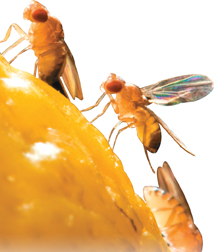A Summary of Mendel's Principles
 What did Mendel contribute to our understanding of genetics?
What did Mendel contribute to our understanding of genetics?
As you have seen, Mendel's principles of segregation and independent assortment can be observed through one- and two-factor crosses.  Mendel's principles of heredity, observed through patterns of inheritance, form the basis of modern genetics. These principles are as follows:
Mendel's principles of heredity, observed through patterns of inheritance, form the basis of modern genetics. These principles are as follows:
The inheritance of biological characteristics is determined by individual units called genes, which are passed from parents to offspring.
Where two or more forms (alleles) of the gene for a single trait exist, some alleles may be dominant and others may be recessive.
In most sexually reproducing organisms, each adult has two copies of each gene—one from each parent. These genes segregate from each other when gametes are formed.
Alleles for different genes usually segregate independently of each other.
Mendel's principles don't apply only to plants. At the beginning of the 1900s, the American geneticist Thomas Hunt Morgan wanted to use a model organism of another kind to advance the study of genetics. He decided to work on a tiny insect that kept showing up, uninvited, in his laboratory. The insect was the common fruit fly, Drosophila melanogaster, shown in Figure 11–11. Drosophila can produce plenty of offspring—a single pair can produce hundreds of young. Before long, Morgan and other biologists had tested all of Mendel's principles and learned that they applied to flies and other organisms as well. In fact, Mendel's basic principles can be used to study the inheritance of human traits and to calculate the probability of certain traits appearing in the next generation. You will learn more about human genetics in Chapter 14.

FIGURE 11–11 A Model Organism The common fruit fly, Drosophila melanogaster, is an ideal organism for genetic research. These fruit flies are poised on a lemon.
11.2 Assessment

-
Review What is probability?
Use Models How are Punnett squares used to predict the outcomes of genetic crosses?
-
Review What is independent assortment?
Calculate An F1 plant that is homozygous for shortness is crossed with a heterozygous F1 plant. What is the probability that a seed from the cross will produce a tall plant? Use a Punnett square to explain your answer and to compare the probable genetic variations in the F2 plants.

-
Review How did Gregor Mendel contribute to our understanding of inherited traits?
Apply Concepts Why is the fruit fly an ideal organism for genetic research?
Apply the Big idea
Suppose you are an avid gardener. One day, you come across a plant with beautiful lavender flowers. Knowing that the plant is self-pollinating, you harvest its seeds and plant them. Of the 106 plants that grow from these seeds, 31 have white flowers. Using a Punnett square, draw conclusions about the nature of the allele for lavender flowers.

Table of Contents
- Formulas and Equations
- Applying Formulas and Equations
- Mean, Median, and Mode
- Estimation
- Using Measurements in Calculations
- Effects of Measurement Errors
- Accuracy
- Precision
- Comparing Accuracy and Precision
- Significant Figures
- Calculating With Significant Figures
- Scientific Notation
- Calculating With Scientific Notation
- Dimensional Analysis
- Applying Dimensional Analysis




